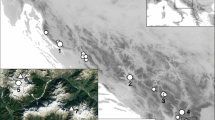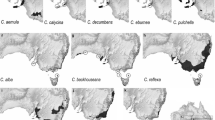Abstract
As part of a larger investigation of theC. alpinum-C. arcticum complex of arctic and North Atlantic areas, isozyme variation ofC. alpinum, C. arcticum, and related taxa was analysed. A total of 124 multilocus phenotypes was divided into more or less distinct groups by numerical analyses. Most groups correspond well to previously recognized taxa. However, what has traditionally been considered asC. arcticum was divided into two distinct groups, consisting of northern (Svalbard, Greenland) and more southern (Norway, Iceland) populations, respectively. The division ofC. arcticum into two taxa is also supported by other kinds of data and the two taxa probably deserve species rank. Serpentine plants from Shetland had multilocus phenotypes similar to those ofC. arcticum from Iceland and should be included in the southern taxon.
Similar content being viewed by others
References
Arnold M. L. (1997) Natural hybridization and evolution. Oxford University Press, Oxford.
Ascherson P., Graebner P. (1919) Synopsis der Mitteleuropäischen Flora. V. Band. 1. Abteilung. Borntraeger, Leipzig.
Baig N. A. (1971) Basic chromosome number in the genusCerastium L. Pakistan J. Sci. 23: 267–268.
Boşcaiu M. T. (1996) Multidisciplinary studies on some groups of perennialCerastium species from the Carpathians and the eastern Alps. Ph. D. Thesis, Univ. Wien (unpublished).
Boşcaiu M. T., Marhold K., Ehrendorfer F. (1997a) TheCerastium alpinum group (Caryophyllaceae) in the high mountains of Poland and Slovakia. Phyton (Horn) 37: 1–17.
Boşcaiu M. T., Marhold K., Ehrendorfer F. (1997b) Typification of several names of theCerastium alpinum group (Caryophyllaceae). Willdenowia 27: 39–45.
Brett O. E. (1951) Chromosome numbers ofCerastium species. Nature 168: 793–794.
Brett O. E. (1952) Basic chromosome numbers in the genusCerastium. Nature 170: 251–252.
Brett O. E. (1955) Cyto-taxonomy of the genusCerastium. I. Cytology. New Phytol. 54: 138–148.
Brochmann C. (1992) Polyploid evolution in arctic-alpineDraba (Brassicaceae). Sommerf. Suppl. 4: 1–37.
Brochmann C. (1995) Arctic biodiversity is underestimated: new insights from evolutionary and molecular genetic studies. Univ. Trondheim Vitensk. Mus. Rapp. Bot. Ser. 1995 3: 18–20.
Brochmann C., Gabrielsen T. M., Hagen A., Tollefsrud M. M. (1996) Seed dispersal and molecular phylogeography: glacial survival, tabula rasa, or does it really matter? Det Norske Videnskaps-Akademi. I. Mat.Nat.Kl. Avh. Ny Serie 18: 54–68.
Brochmann C., Soltis P. S., Soltis D. E. (1992) Multiple origins of the octoploid Scandinavian endemicDraba cacuminum: electrophoretic and morphological evidence. Nordic J. Bot. 12: 257–272.
Brummitt R. K., Kent D. H., Lusby P. S., Palmer R. C. (1987) The history and nomenclature of Thomas Edmondston's endemic ShetlandCerastium. Watsonia 16: 291–297.
Brysting A. K., Elven R., Nordal I. (1997) The hypothesis of hybrid origin ofPoa jemtlandica supported by morphometric and isozyme data. Nordic J. Bot. 17: 199–214.
Brysting A. K., Hagen A. (in press) Species in polyploid complexes? TheCerastium alpinum-C. arcticum complex. Det Norske Videnskaps-Akademi. I. Mat. Nat. Kl. Avh. Ny Serie.
Brysting A. K., Hagen A., Borgen L. (1996) Chromosome studies of the polyploidsCerastium alpinum L. andC. arcticum Lange (Caryophyllaceae). Abstract, IV Conference on Plant Taxonomy, Barcelona, Spain.
Böcher T. W. (1977)Cerastium alpinum andC. arcticum, a mature polyploid complex. Bot. Not. 130: 303–309.
Böcher T. W., Fredskild K. H., Jakobsen K. (1978) Grønlands Flora. 3rd edn. P. Haase and Søns, Copenhagen.
Böcher T. W., Larsen K. (1950) Chromosome numbers of some arctic and boreal flowering plants. Meddel. Grønland 147: 1–32.
Carter S. P., Proctor J., Slingsby D. R. (1987) Soil and vegetation of the Keen of Hamar serpentine, Shetland. J. Ecol. 75: 21–42.
Dubiel E. (1990) Vascular plants of the NW part of Sörkappland (Spitsbergen). Distribution and habitats. Zesz. Nauk. Uniw. Jagiellon Prace Bot. 21: 7–33.
Elven R., Elvebakk A. (1996) Part 1. Vascular plants. In: Elvebakk A., Prestrud P. (eds.) A catalogue of Svalbard plants, fungi, algae, and cyanobacteria. Norsk Polarinst. Skr. 198: 9–55.
Engelskjøn T. (1979) Chromosome numbers in vascular plants from Norway, including Svalbard. Opera Bot. 52: 1–38.
Goldblatt P. (1981) Index to plant chromosome numbers 1975–1978. Missouri Botanical Garden. Braun-Brumfield Inc., Michigan.
Grundt H. H. (1996) Comparative morphology, reproduction, and ecology ofCerastium alpinum L. (Caryophyllaceae) in Central Norway. Cand. Scient. thesis, Univ. Oslo (unpublished).
Grundt H. H., Borgen L., Elven R. (in press) Aspects of reproduction inCerastium alpinum L. on calcic and ultramafic soils in Central Norway. Nordic J. Bot. 19 (4).
Hagen A., Giese H., Brochmann C. (1996) Phylogeography ofCerastium arcticum (Caryophyllaceae) investigated using RAPD and SCAR analyses. Abstract, IV Conference on Plant Taxonomy, Barcelona, Spain.
Hagen A., Schjøll O., Brochmann C., Elven R., Nordal I., Borgen L. (1995) Genetic variation in the polyploidsCerastium alpinum andC. arcticum (Caryophyllaceae): morphology, isozymes and RAPDs. Abstract, VI International Symposium IOPB, Tromsø, Norway.
Hagen A., Sæther T. (1993). En komparativ studie avCerastium alpinum L. andC. arcticum Lange, med vekt på variasjonen innen et område på Dovrefjell. Cand. Scient. thesis, Univ. Oslo (unpublished).
Hartman C. J. (1820) Handbok i Skandinaviens flora. 1st edn. Stockholm.
Hultén E. (1955)Cerastium glabratum Hartm., species restituenda. Arch. Soc. Zool. Bot. Fenn. Vanamo Suppl. 9: 62–69.
Hultén E. (1956) TheCerastium alpinum complex. A case of world-wide introgressive hybridization. Svensk Bot. Tidskr. 50: 411–495.
Hultén E., Fries M. (1986) Atlas of North European vascular plants north of the Tropic of Cancer. Koeltz Scientific Books, Königstein.
Jalas J., Suominen J. (1983) Atlas florae europaeae. Distribution of vascular plants in Europe 6. Caryophyllaceae (Alsinoideae and Paronychioideae). Helsingin Liikekirjapaino, Helsinki.
Jalas J., Wyse Jackson M. B., Sell P. D., Whitehead F. H. (1993)Cerastium L. In: Tutin T. G., Burges N. A., Chater A. O., Edmondson J. R., Heywood V. H., Moore D. M., Valentine D. H., Walters S. M., Webb D. A. (eds.) Flora Europea 1. 2nd edn. Cambridge University Press, Cambridge, pp. 164–174.
Jørgensen C. A., Sørensen T., Westergaard M. (1958) The flowering plants of Greenland. A taxonomical and cytological survey. Biol. Skr. Dan. Videnskabernes Selskab 9(4): 1–172.
Kephart S. R. (1990) Starch gel electrophoresis of plant isozymes: a comparative analysis of techniques. Amer. J. Bot. 77: 693–712.
Knaben G., Engelskjøn T. (1967) Chromosome numbers of Scandinavian arctic-alpine plant species II. Acta Boreal. A. Sci. 21: 1–57.
Kruckeberg A. R., Kruckeberg A. L. (1990) Endemic metallophytes: Their taxonomic, genetic and evolutionary attributes. In: Shaw A. J. (ed.) Heavy metal tolerance in plants: Evolutionary aspect. CRC Press, Boca Raton Florida, pp. 301–312.
Lamarck J. B. A. P. M. de (1785) Encyclopédie méthodique. Botanique 1. Panckoucke, Paris.
Lid J., Lid D. T. (1994) Norsk flora. 6th edn. by Elven, R. Det norske samlaget, Oslo.
Lokki J., Saura A. (1980) Genetic polymorphism and evolution in parthenogenetic animals. XI. Genetic differentiation in parthenogenetic populations. Hereditas 92: 275–282.
Lusby P. S. (1984) The history and taxonomy of the Shetland taxon ofCerastium arcticum Lange. B. Sc. thesis, Univ. Aberdeen (unpublished).
Löve Á., Löve D. (1956) Cytotaxonomical conspectus of the Icelandic flora. Acta Horti Gothob. 20: 65–291.
Murbeck S. (1898) Studier öfver kritiska kärlväxtformer. III. De nordeuropeiska formerna af slägtetCerastium. Bot. Not. 1898: 241–268.
Murray D. F. (1995) Causes of arctic plant diversity. In: Chapin III F. S., Körner C. (eds.) Arctic and alpine biodiversity: patterns, causes and ecosystem consequences. Springer, Berlin, pp. 21–32.
Nilsson Ö. (1991) Nordisk fjällflora. Bonniers, Stockholm.
Proctor J., Woodell R. J. (1971) The plant ecology of serpentine. I. Serpentine vegetation of England and Scotland. J. Ecol. 59: 375–395.
Rohlf F. J. (1990) NTSYS-pc. Numerical taxonomy and multivariate analysis system. Version 1.60. Exeter Software, New York.
Rune O. (1953) Plant life on serpentines and related rocks in the north of Sweden. Acta Phytogeogr. Suec. 31: 1–135.
Rune O. (1988) Serpentinfloran i Skandinavien. Blyttia 46: 43–51.
Schjøll O. (1995) Amfiatlantisk variasjon innenCerastium alpinum L. ogC. arcticum Lange. Cand. Scient. thesis, Univ. Oslo (unpublished).
Scott W., Palmer R. (1987) The flowering plants and ferns of the Shetland Islands. The Shetland Times Ltd., Lerwick.
Sokolovskaya A. P., Strelkova O. S. (1960) Geographical distribution of the polyploid species of plants in the Euroasiatic arctic. Bot. Zhurn. 45: 369–381.
Soltis D. E., Haufler C. H., Darrow D. C., Gastony G. J. (1983) Starch gel electrophoresis of ferns: a compilation of grinding buffers, gel and electrode buffers, and staining schedules. Amer. Fern. J. 73: 9–27.
Söllner R. (1953) Sur l'emploi des critères cytologiques dans la taxonomie du genreCerastium. Bull. Soc. Neuchâteloise Sci. Nat. 76: 121–132.
Tolmachev A. I. (1930) Die GattungCerastium in der Flora von Spitzbergen. Skr. Svalb. Ishavet 34: 1–8.
Tolmachev A. I. (1971) Flora Arctica URSS. VI. Caryophyllaceae-Ranunculaceae. Nauka, Moscow Leningrad.
Wendel J. F., Weeden N. F. (1989) Visualization and interpretation of plant isozymes. In: Soltis D. E., Soltis P. S. (eds.) Isozymes in plant biology. Dioscorides Press, Oregon, pp. 5–45 (Advances in Plant Sciences series, vol. 4).
Werth C. R. (1989) The use of isozyme data for inferring ancestry of polyploid pteridophytes. Biochem. Syst. Ecol. 17: 117–130.
Westerbergh A. (1994) Evolution ofSilene dioica on serpentine. Department of Genetics, Umeå University, Sweden.
Westerbergh A., Saura A. (1992) The effect of serpentine on the population structure ofSilene dioica (Caryophyllaceae). Evolution 46: 1537–1548.
Author information
Authors and Affiliations
Rights and permissions
About this article
Cite this article
Brysting, A.K., Borgen, L. Isozyme analysis of theCerastium alpinum-C. arcticum complex (Caryophyllaceae) supports a splitting ofC. arcticum Lange. Pl Syst Evol 220, 199–221 (2000). https://doi.org/10.1007/BF00985046
Received:
Accepted:
Issue Date:
DOI: https://doi.org/10.1007/BF00985046




